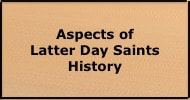bigpigeon.us webpage History > LDS History, updated by RAC 14 Feb 2020.
==> Part 1- Links to my Latter Day Saints History materials:
- Latter Day Saints History Links (webpage) - web links I have used in my LDS research.
- Gallery 1 - Mormon Maps (webpage) - several maps related to the Mormon migration to Utah.
- Mormons in the Big Pigeon Area (report) - a miscellany of Mormon-related items. (24 pp., updated 24 Jan '18).
- The Older Descendants of Samuel Wood (report) - Samuel Wood, an ancestor of my oldest daughter, was a member of the RLDS Church and a pioneer of Harrison County, Iowa.
- A House Divided (webpage) - complements a once-planned article in The Bridge about Kirsten Pedersen's extended family.
==> Part 2 - About My LDS History Webarea.
I believe the Big Pigeon area is worthy of more attention than it has received from Mormon historians. It figures into Mormon history in two ways:
- The header image is a sketch of Samuel Wood, an early settler in Union Township, Harrison County, Iowa and an ancestor of my oldest daughter. Samuel Wood survived the Hahn's Mill massacre in Missouri in 1837.
I believe the Big Pigeon area is worthy of more attention than it has received from Mormon historians. It figures into Mormon history in two ways:
- During the years from 1846 through 1852, most Mormons crossing to Utah first gathered along the Missouri River in the southwestern Iowa area. Several Mormon camps were located near Pigeon Creek, then known as Big Pigeon Creek. Winter Quarters lay across the Missouri River from the Big Pigeon vicinity.
- Some Mormons remained in the Big Pigeon vicinity rather than crossing to Utah. Others later returned from Utah and settled in the vicinity, where they were joined by yet more Mormon immigrants who never crossed. Thus a number of Reorganized Latter Day Saints (RLDS) congregations were established in the Big Pigeon vicinity. Several congregations, now known as the Community of Christ, remain active today in nearby towns. In particular, the area to the north in Harrison County had (and still has) a substantial RLDS (now Community of Christ) presence, especially of descendants of English and Danish Mormon immigrants.


